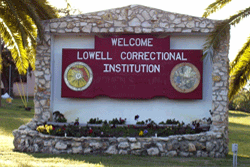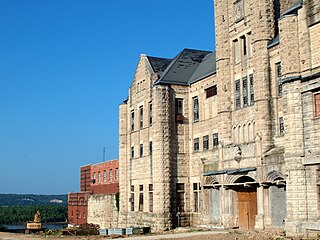
Minnesota Correctional Facility – Oak Park Heights (MCF-OPH) is Minnesota's only Level Five maximum security prison. The facility is located near the cities of Bayport and Stillwater. The facility is designed and employed with trained security officers to handle not only Minnesota's high-risk inmates but other states' as well. They also have the largest contract to house federal inmates with serious, violent histories. The prison has never had an escape, and only one homicide.

The Minnesota Correction Facility – Stillwater (MCF-STW) is a close custody state prison for men in Bayport, Minnesota, United States. Built 1910–1914, it houses 1,600 inmates in seven different living areas. Additionally, approximately 100 inmates are housed in a nearby minimum security area. It replaced the original Minnesota Territorial Prison located just to the north in the city of Stillwater, Minnesota. Until recent expansion of the medium custody Minnesota Correctional Facility – Faribault, MCF-STW was the state's largest facility by inmate population. A historic district consisting of 22 contributing properties was listed on the National Register of Historic Places in 1986 as the State Prison Historic District for having state-level significance in architecture. It was nominated for being one of the nation's earliest and most influential appearances of the "telephone pole" layout, with a large main hallway connecting each of the units, that was widely adopted by high-security prisons. MCF-STW is noted for its award-winning publication The Prison Mirror, the oldest continuously-operated prison newspaper in the United States.
The Iowa State Penitentiary (ISP) is an Iowa Department of Corrections maximum security prison for men located in the Lee County, Iowa, community of Fort Madison. This facility should not be confused with the Historical Iowa State Penitentiary, which was shut down in 2015 after being open for 175 years. The HISP itself was a 550-person maximum security unit. Also on the complex was a John Bennett Correctional Center - a 169-person medium security unit. The HISP included two minimum-security farms with about 170 people who were located within a few miles of the main complex. The complex also had a ten-person multiple care unit, and a 120-bed special-needs unit for prisoners with mental illness or other diseases that require special medical care. In total, there were about 950 inmates and 510 staff members.
Elmira Correctional Facility, also known as "The Hill," is a maximum security state prison located in Chemung County, New York, in the City of Elmira. It is operated by the New York State Department of Corrections and Community Supervision. The supermax prison, Southport Correctional Facility, is located two miles away from Elmira.
The Pendleton Correctional Facility, formerly known as the Indiana Reformatory, is a state prison located in Fall Creek Township, Madison County, near Pendleton and about 25 miles (40 km) northeast of Indianapolis. Established in 1923, it was built to replace the Indiana State Reformatory located in Jeffersonville after a fire severely damaged the original property. The Pendleton facility currently offers maximum and minimum-security housing for adult males over 22 years old. The maximum-security portion is made up of 31 acres (130,000 m2) surrounded by a concrete wall. It has an average daily population of approximately 1,650 inmates. Located on the grounds outside the enclosure, the minimum-security dormitory holds approximately 200 prisoners on a daily basis.
The Westville Correctional Facility, located in Westville, Indiana, is a state-operated prison for adult males. The facility contains sections of three levels of security. The average daily population in September 2006 was approximately 3,100. At Westville, 49% of the inmate population are people of color, slightly higher than the average of 42% for the Indiana Department of Correction (DOC) as a whole.

The United States Penitentiary, Terre Haute is a maximum-security United States federal prison for male inmates in Terre Haute, Indiana. It is part of the Federal Correctional Complex, Terre Haute and is operated by the Federal Bureau of Prisons, a division of the United States Department of Justice. USP Terre Haute houses a Special Confinement Unit for male federal inmates who have been sentenced to death as well as the federal execution chamber. Most inmates sentenced to death by the U.S. federal government are housed in USP Terre Haute prior to execution, with few exceptions. FCC Terre Haute is located in the city of Terre Haute, 70 miles (110 km) west of Indianapolis.

The Indiana Women's Prison was established in 1873 as the first adult female correctional facility in the country. The original location of the prison was one mile (1.6 km) east of downtown Indianapolis. It has since moved to 2596 Girls School Road, former location of the Indianapolis Juvenile Correctional Facility. As of 2005, it had an average daily population of 420 inmates, most of whom are members of special-needs populations, such as geriatric, mentally ill, pregnant, and juveniles sentenced as adults. By the end of 2015, the population increased to 599 inmates. Security levels range from medium to maximum. The prison holds Indiana's only death row for women; however, it currently has no death row inmates. The one woman under an Indiana death sentence, Debra Denise Brown, had her sentence commuted to 140 years imprisonment in 2018 and is being held in Ohio.

The Texas Department of Criminal Justice (TDCJ) is a department of the government of the U.S. state of Texas. The TDCJ is responsible for statewide criminal justice for adult offenders, including managing offenders in state prisons, state jails, and private correctional facilities, funding and certain oversight of community supervision, and supervision of offenders released from prison on parole or mandatory supervision. The TDCJ operates the largest prison system in the United States.
New Castle Correctional Facility is a privately run prison located in New Castle, Indiana, United States. It opened in 2002. In September 2005, the state signed a contract with the for-profit GEO Group, Inc. of Boca Raton, Florida, to run the prison. The facility is rated as minimum- to medium-security, but also has a maximum-security psychiatric unit and annex. It is currently the second-largest prison in Indiana, and can hold approximately 3,270 inmates.
Rockville Correctional Facility is a state prison located in Adams Township, Parke County, one mile (1.6 km) northwest of Rockville, Indiana. A part of the Indiana Department of Corrections, it is the largest state prison for women in Indiana with approximately 1,200 women. Although it is classified as a medium-security prison, it has inmates of all security levels.
Edinburgh Correctional Facility is a minimum-security work camp located in the middle of Camp Atterbury, a military training camp near Edinburgh, Indiana. The inmates work on the grounds of Camp Atterbury and on road crews with the Indiana Department of Transportation and park maintenance with the Indiana Department of Natural Resources. The maximum population, which has doubled in the past year, is 344 adult males.
The Pendleton Juvenile Correctional Facility is a maximum-security Indiana Department of Corrections prison for juvenile males between the ages of 12 and one minute before they turn 22. The facility is located in Fall Creek Township, Madison County, southwest of Pendleton. The campus-style facility has an average daily population of 245 males. The Pendleton Facility was established in 2000 with the purpose of "preparing young men for re-entry into society with the necessary skills to avoid further criminal behavior."
The Correctional Industrial Facility, otherwise known as the CIF, is an Indiana Department of Corrections prison located in Fall Creek Township, Madison County, near Pendleton. It is a medium-security prison. As of 2019, the prison housed 1,471 inmates, and employed 307 staff. Constructed in 1985, CIF formerly housed the Indiana Department of Correction's PEN food products plant. However, the food products plant was replaced by a brake refurbishing factory in partnership with the industrial company Meritor, which is the largest employer of offenders in the facility. Wendy Knight is the current Warden of CIF.
The Indianapolis Juvenile Correctional Facility was a minimum, medium, and maximum state juvenile facility of the Indiana Department of Correction. It was located on Girls School Road, 8 miles (13 km) west of downtown Indianapolis. The facility currently houses 185 female inmates ranging in age from twelve years to twenty-one years. The facility was originally established in 1907 as an all-girls school and was known for most of its history as the Indiana Girls School. In 2006, juvenile male offenders were assigned to the facility as well. In late 2007 all male offenders were transferred to other state facilities and the Indianapolis Juvenile Correctional Facility reverted to being an all female facility. In 2009 the girls were moved to the Madison Juvenile Correctional Facility, and the former IJCF became the current location of the Indiana Women's Prison.

The Department of Public Safety and Corrections (DPS&C) is a state law enforcement agency responsible for the incarceration of inmates and management of facilities at state prisons within the state of Louisiana. The agency is headquartered in Baton Rouge. The agency comprises two major areas: Public Safety Services and Corrections Services. The secretary, who is appointed by the governor of Louisiana, serves as the department's chief executive officer. The Corrections Services deputy secretary, undersecretary, and assistant secretaries for the Office of Adult Services and the Office of Youth Development report directly to the secretary. Headquarters administration consists of centralized divisions that support the management and operations of the adult and juvenile institutions, adult and juvenile probation and parole district offices, and all other services provided by the department.

Lowell Correctional Institution is a women's prison in unincorporated Marion County, Florida, north of Ocala, in the unincorporated area of Lowell. A part of the Florida Department of Corrections, it serves as the primary prison for women in the state. Almost 3,000 women are incarcerated in the complex, which includes the Lowell Annex. As of 2015 2,696 women are in the main Lowell CI, making it the largest prison for women in the United States; its prison population became larger than that of the Central California Women's Facility that year.

The Idaho Department of Correction (IDOC) operates nine prisons, four community release centers and 20 probation and parole offices in seven districts located throughout the state of Idaho. The agency has its headquarters in Boise.

The Missouri State Penitentiary was a prison in Jefferson City, Missouri, that operated from 1836 to 2004. Part of the Missouri Department of Corrections, it served as the state of Missouri's primary maximum security institution. Before it closed, it was the oldest operating penal facility west of the Mississippi River. It was replaced by the Jefferson City Correctional Center, which opened on September 15, 2004.
Earnest C. Brooks Correctional Facility (LRF) is a Michigan prison, located in Muskegon, for adult male prisoners.










